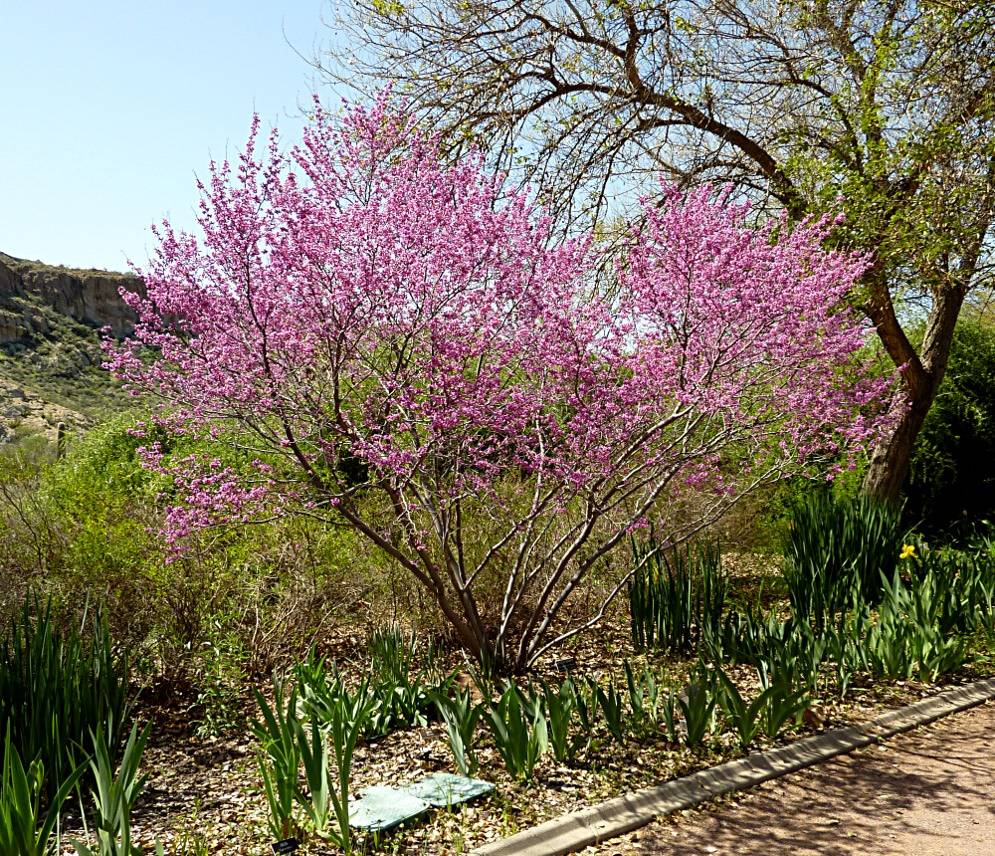Western redbud works better in desert climate
Q: I can never find Cercis occidentalis, western redbud, at local nurseries. Any idea where I can locate it?
A: Thanks for giving me the Latin name for this tree instead of just western redbud, because that eliminates all confusion about which tree you might mean. If you like a reddish pink splash of color on a small tree, you will like this tree when it flowers in early spring. The redbud most people buy is an eastern redbud, but it is not as suitable for our climate and soils as its western cousin or even the Mexican redbud.
Eastern redbud is the tree that people call “redbud” from the East Coast to the West Coast. Western redbud is unique. It has never gained the same popularity. This is the same tree that polka dots the Grand Canyon with rosy plum color every spring.
But western redbud has significant advantages over the eastern redbud in our climate and soils. First off, western redbud handles the chemistry of our soils much better than eastern redbud. That’s because it evolved here.
It is native to Southern Nevada and specifically the Spring Mountains of Southern Nevada. It is small, seldom reaching more than 20 feet tall, the perfect size for a single-story home and smaller patio-sized landscapes.
However, it will not tolerate having wet feet. In other words, don’t water it too often. Give it a lot of water when you do water it, and then hold off and let the soil dry before you water it again.
It is native to the foothills of dry Southwestern areas, including Utah, Arizona and California. It’s one of our desert natives.
I also think the western redbud is a prettier tree when it’s flowering than the plain old redbud.
Try our Las Vegas State Forest Nursery located in the north part of the valley. It specializes in local native plants. For information, call 702-486-5411.
Q: My tangerine tree’s leaves are curling inwards. Most have very small black spots on them. I observed the leaves and don’t see any insects. I do deep hose watering during hot summer days.
A: There are lots of reasons for citrus leaves curling. This problem is near legendary for citrus leaves, but the reason is usually environmental and not from insects or disease. I’m not saying it can’t happen, but it’s less likely.
Since this question was sent to me at the end of winter, cold weather comes to mind. Cold temperatures can cause leaves to roll. Some say cold weather can cause leaf spotting as well.
If leaf rolling was during the summer, guess what? High temperatures can also cause citrus leaves to roll.
Moisture stress can cause leaf roll and leaf drop. When timing irrigations, make sure the soil is no longer wet when the irrigation water is applied. In the same token, make sure the soil does not get too dry between irrigations. Dry and wet soils can cause leaf rolling.
What’s more important, in my opinion, is overall tree health. Plants in poor health are more susceptible to problems than those that are healthy.
In the picture you sent, I noticed the condition of the soil surrounding these trees. The soil looked pretty bad, even by Las Vegas standards. Poor soil conditions lead to poor plant health in the future.
Good soil health begins at the time of planting. I realize your tree has already been planted, but soil improvement surrounding the roots at the time of planting is a huge investment in plant health for years to come.
In the future, excavate the planting hole 3 to 4 feet in diameter and 18 inches deep at the center. Mix good compost with your excavated soil at a rate of about 1:1; for every shovelful of soil, mix one shovelful of compost.
What can you do now? Put a half bag of compost on the soil surrounding the tree. On top of this, put a 4- to 6-inch layer of wood chips and water it in. Where irrigation water is present, wood chips improve the soil health where most of the feeder roots of your tree are living.
Improving the soil improves water, fertilizer and nutrient uptake by these roots, which in turn improves the overall health of the tree. Soil improvement using this method helps remove some irrigation problems that could be causing leaf rolling. Overall, this means fewer problems for your citrus in the future.
Get free wood chips by visiting Cooperative Extension locations south of the airport or in North Las Vegas at the University Orchard in the Aliante community. For more information about these free wood chips, call the extension hotline at 702-257-5555.
Q: I put off pruning my lantana. It bloomed until about two weeks ago. Now it is starting to cycle through the dying and rebuilding process. Can I prune it back now, the normal way, and still have good growth?
A: So, I take it, you did not prune your lantana this winter because it did not freeze. Or you just forgot. Now you are wondering if it’s too late to prune. No, it’s not too late. Do it now, even though it’s starting to grow again.
Lantana is what we call an herbaceous perennial in our climate. Winter temperatures are usually cold enough that the top freezes to the ground each winter. Spring pruning removes the top, close to the ground, and it regrows again from its base or crown. This winter, it did not get cold enough.
You know it has the potential to grow from its base. Cut it back hard to within 1 inch of the soil surface and it will sucker below these cuts. Give it some fertilizer and water after you make the pruning cuts.
Bob Morris is a horticulture expert and professor emeritus of the University of Nevada, Las Vegas. Visit his blog at xtremehorticulture.blogspot.com. Send questions to Extremehort@aol.com.


















